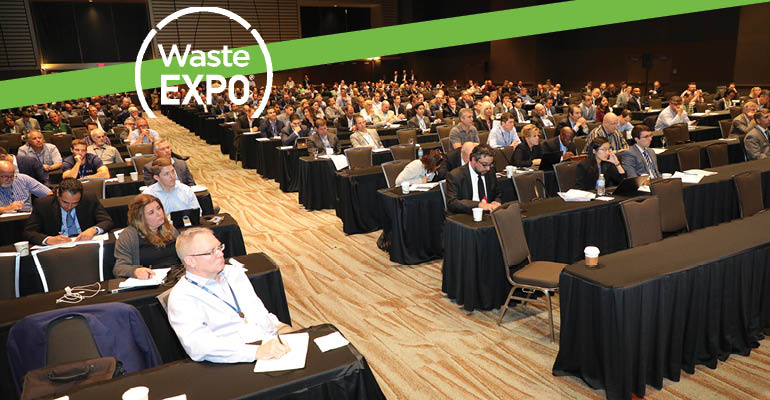With more than 50 sessions taking place across a variety of tracks and co-located events, there were a mountain of insights from Day One at WasteExpo.

WasteExpo 2017 started off with a flourish on Monday as attendees flocked to more than 50 different sessions and panels, including sessions at the Composting & Organics Recycling Conference, the Food Recovery Forum, the EREF Summit and the Waste360 Investor Summit. The first night of the conference concluded with a welcome reception at the Marquee Nightclub and Dayclub at the Cosmopolitan Hotel.
Here are some key takeaways from the first day of WasteExpo:
Waste Connections CEO Ron Mittelstaedt said that the integration with Progressive Waste has “gotten materially better and worked out better than we had thought” during the Investor Summit. The one surprise on the negative side was the poor condition of the fleet in many markets—something the company is now working to address. Mittelstaedt also said the company has been able to instill its “Servant Leadership” management on the Progressive side.
In terms of business operations, Mittelstaedt estimated that service increases are far outpacing service decreases. As a result, in some markets Waste Connections is pushing full capacity. It is working to add routes and equipment in order to relieve some of the strain.
Mittelstaedt also acknowledged the company is looking at how best to use data. “We gather a lot of data, but we use little of it,” Mittelstaedt said. “What matters is looking at 10 to 15 things on macro basis in real time. … You need to have the pieces of data that drive the business and focus on those pieces.”
Casella Waste CEO John Casella talked about the company’s success in improving its pricing and fixing its recycling business. Among other tactics, better customer data measures have allowed Casella to increase prices. It has also pushed out collection and disposal business where it has proven to be unprofitable. In terms of recycling, Casella’s model of putting in a base price for recycling services has helped it manage fluctuations in commodities prices.
Casella is ahead of schedule in its current three-year plan. What lies ahead could be additional organic growth as well as potentially a merger or sale of the company.
Covanta CEO Stephen Jones provided insights on the firm’s three main lines of business—energy from waste, recycled metals and environmental services. On the metals front, Covanta now has a ferrous cleaning system in Pennsylvania to help it produce higher quality metals from what it recovers in its waste stream. It is also looking to start up a non-ferrous cleaning plant. “Aluminum buyers don’t want copper or brass in there,” Jones explained. “We’re looking to get more from that base business and move up the quality chart.”
Covanta does not see much opportunity for new waste-to-energy plants in the U.S., but the picture is different internationally. It sees a number of opportunities in the United Kingdom, Australia and China. Down the line, India could be a growth market as well. “They have to get a better handle on collections first,” Jones said.
At Waste Management, the transition to the leadership of new CEO Jim Fish has been a smooth one. Fish’s long tenure with the company before his ascension gave him a great understanding of the business and how to push forward on areas of improvement.
Among other initiatives, Waste Management is looking at future recycling technologies that could displace the landfill disposal model. However, it has not found something yet that is scalable or economically viable to replace the need for landfills.
Advanced Disposal CEO Richard Burke summed up overall sentiment as "Garbage is good." One proxy: for every $1 in service decreases the company has experienced from some clients being offset by $1.70 in service increases from others, producing robust net growth.
Advanced Disposal has focused on consolidating back office functions in order to streamline operations at the branch level. For example, it now has 140 outside sales reps and 75 percent of its service calls go through call centers. “This has given local managers the autotomy to run businesses based on service delivery, safety and growing their market,” Burke said.
Burke also emphasized the firm’s focus on safety. “We talk about service first, safety always,” Burke said. “Safety is too important to be ranked.”
GFL Environmental CEO Patrick Dovigi provided highlights on the company’s growth in Canada and its foray into the United States. In Canada, Dovigi estimated that between 28 and 30 percent of the market is controlled by GFL, Waste Management and Waste Connections. That leaves ample opportunity for growing market share. In the U.S. the company faced some challenges in absorbing Rizzo Environmental given some of the issues the Michigan-based hauler was facing. GFL has quickly moved to rebrand and also met with customers to reassure them. “We didn’t lose a contract,” Dovigi said. “In fact, we picked up some new ones.”
Republic Services sees the business still in the early stages of a waste recovery. This is particularly true in the East, but the West is also still seeing strong fundamentals and continued room for growth. Like with other haulers, Republic reported that service upgrades are outpacing cancellations and downgrades.
At the Environmental Research & Education Foundation (EREF) Summit welcome session, Stephanie Bolyard of EREF, Michael Darnell of Republic Services and Kurt Shaner of Waste Connections spoke about the state of leachate management and treatment in the U.S. Bolyard explained that management of leachate is challenging for landfill operators and that there was an estimated 7.1 billion gallons of leachate generated in 2010. She also shared that relevant descriptive data that connects leachate quality and treatment challenges with landfill characteristics, such as waste wage, types of waste accepted and composition and climate, are scarce.
EREF is currently conducting a survey on leachate quantity and quality and management practices at landfills in the U.S. To date, the survey has received 154 responses and data on volume produced, end point for disposal, treatment processes used and parameter concentrations that impact treatment strategy. The survey will remain open to interested participants through the end of June.
Darnell shared that almost 1.5 billion gallons of leachate were disposed of at Republic Services’ facilities in 2016, 47 of which have some level of leachate treatment. He also explained that leachate is driven by changes in gas system management, landfill dynamics and changing regulatory environment.
Shaner unveiled that Waste Connections generated 158.9 million gallons of leachate in its eastern region in 2016 and that on average, leachate costs have gone up 500 percent in the past six years. He also shared that the company’s leachate disposal concerns are lack of dependability and increasing costs.
During the “Big Data & Smart Waste” session, Amity Lumper of Cascadia, Don Ross of Kessler Consulting, Jason Gates of Compology and Waste360 40 Under 40 award recipient and Scott Lukach of Rehrig Pacific discussed what the growth of big data means for waste and recycling.
Ross kicked off the session with the quote, “If you can’t measure it, you can’t manage it.” He shed light on how data can be used for service verification, fleet and telematics, route optimization, bin volume, behavior tracking and smart cities. He also predicted that big data will be used for predictive service models, crowd-sourced pickups, demographic route planning, machine learning, the Internet of Things, and data visualization in the future.
Lukach made the case that big data is changing the way we live and how we communicate with each other. Changing times require a changing strategy, and big data can help with that. He also said that cities have reams of data, and they are thirsty for more in the digital age.
Gates gave a broad overview of Compology and its service offerings. In addition, he stated that “thanks to low costs and reliable sensible technologies, collecting data is no longer the hard part of the big data process.” Gates also commented that using a cloud-based architecture can give you more flexibility when it comes to managing your data.
At the “Landfill Innovative Cover Solutions” deep dive discussion, David Cieply of Watershed Geosynthetics, Michael Kukuk of Blackstone Environmental, Elliot Pugh of Wind Defender and Charlie Sedlock of Hamm, Inc. explored the ins and outs of innovative landfill cover solutions.
Sedlock touched on the closure concept and goals at Hamm Sanitary landfill, which include improving and increasing the integrity and performance of the landfill, its systems and the protection of the environment, safely and conservatively provide for closure and post closure of the facility and leveraging the landfill closure design and construction to create approximately 600 acres of natural habitats. The closure concept, which is the critical first step, includes creating an adaptive reuse of a close landfill that transforms how Kansans view landfills, restoring Kansas savanna conditions and wildlife, creating the landscape and framework for future activities like hiking and biking, developing a green space asset in Kansas through sound innovative engineering and environmental design and improving the quality of life and recreational opportunities in northeast Kansas.
Kukak explained why members of the industry should consider ET-Tree covers for their landfills. Some benefits include lowering operation and maintenance costs, minimizing long-term integrity issues versus Sub D and improving wildlife habitat. He also shared that in order to measure the success of your landfill cover solutions you need to establish easy-to-understand success criteria. Also, as a fun fact, he said that birds can serve as landscape architects, dispersing seeds for “volunteer” trees.
Pugh spoke about the benefits of exposed geomembranes, which can reduce leachate generation, control erosion and provide UV protection. He also explained that wind loading is created from two main effects: cross winds and/or wind uplift.
Cieply claimed that ClosureTurf, one of its products, is the only solution that provides a predictable benchmark of performance, which allows you to determine construction cost, a construction schedule, technical performance, maintenance cost and design life.
During the “From Buying to Selling – M&A Trends session, Brad Page of William Blair & Company and Jeff Wahl of Squire Patton & Boggs covered the dos and don’ts of acquiring and selling businesses.
Page explained that mergers and acquisitions (M&A) includes motivation, preparation, marketing, due diligence, best and final and signing and closing. And, over the years, investors have gotten more comfortable with M&A within the industry. To close out, he stated that the industry is strong and that’s never been in a better position than it is in right now.
Wahl shared that time is the enemy of mergers and acquisitions, and sellers need financial statements, contacts, structure planning, permits and their weird thing to close the deal. He also stated that for a lot of founders, M&A are like Star Trek—their going somewhere they’ve never gone before. On the buyers side, he said they should have a practical approach on environmental risk (insurance, fixes, indemnification, etc.)
At the “Leadership Tips from Industry Icons” session, Ron Bergamini of Action Environmental Group, Mike Paine of Paine’s Inc., Ben Harvey of E.L. Harvey, Chris Weiser of Cram-a-lot and Joe Winter of Winters Bros. gave an overview of what it takes to be a leader in the waste and recycling industry.
Harvey weighed in on the industry’s issue of finding quality drivers, mechanics and other needed positions by stating that labor is going to continue to be a real tough thing for the industry going forward. He also said that even though the industry rides the economy up and down, he doesn’t see any real vulnerability in the marketplace going forward.
Bergamini claimed that technology is moving so fast that the leadership needs to be nimble enough to deal with that, and Paine said that what’s old is new again—he sees the industry heading to where it was when his grandfather launched the company.
Giving advice to the future generation of workers, Winter said it’s important to have a mentor, Bergamini shared that you should find people that you can work with and Weiser advised engaging yourself in the industry, figuring out where you want to go and following that path to have a successful career. Looking forward to the future of the industry, Paine sees segregation coming on board and presenting many challenges and Winter claims recycling equipment is getting better and better, which could ultimately help municipalities and industry members meet diversion goals.
Waste360 sat down with Nate Morris of Rubicon Global to touch base about what the company has been up to. Morris said Rubicon is continuing to work with cities and bring innovation to the forefront of what the future of the industry looks like. He also said that the company’s technologies work well with millennials, who are the future of this industry. Morris said while he doesn’t believe that Rubicon is doing anything revolutionary, he does believe that the company’s playbook could improve various areas of the industry. In five years, he sees the company growing as a consumer-facing brand that invests resources in both culture and people.
About the Author(s)
You May Also Like






